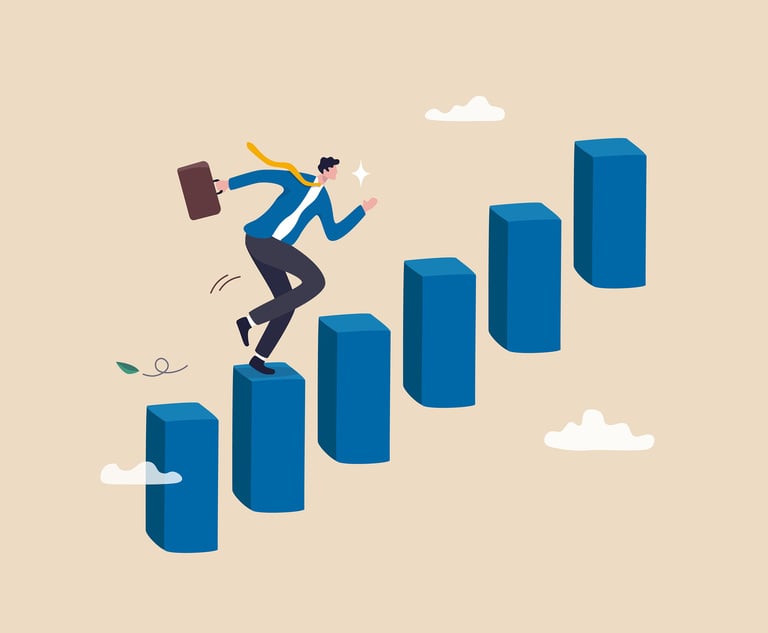The Path to Partnership Offers Great Rewards at Great Costs
There is both pleasure and pain along the way, but every lawyer should strive to be better at their craft, whether they seek partnership or not.
April 29, 2019 at 07:00 PM
10 minute read

Every lawyer's path to partnership is different. And everyone pursues partnership for different reasons. For many, the prestige and pay are a large draw. For some, it is what they always wanted. Others finish law school, get their first job and, being competitive by nature and driven to succeed, staying on track
is the goal. The list goes on. Whatever brings a person to pursue partnership, it remains a milestone in the legal profession, and we encourage all young lawyers to consider partnership if they feel that is the right path for their professional and personal lives.
If partnership is not appealing to you, there are many intangible benefits of developing a mindset and actively working toward the partnership track at your law firm. Like anything in life, being in it to win is a great quality to demonstrate day in and day out, so whether or not being a long-term partner is your career goal, welcoming the opportunity to get better at your craft is key to long-term success in anything you do.
With that background, we strive here to outline some common components of the path to partnership and provide some clarity on what becoming a partner in a law firm really means.
The Path
Step 1 on the path to partnership involves identifying the right practice area or attorneys to work with. This step can take many shapes, but the primary goal is to identify the practice areas that the firm values and where you can thrive. The same is true for individual attorneys at the firm—ideally you would want to work with attorneys who are excellent mentors and have the deal flow or caseload to keep you busy and propel you up the learning curve.
This step can vary as your career progresses, because practice areas and industries wax and wane over the years, and you may need to shift and reinvent yourself over time to ensure you are not standing still in a practice area that no longer aligns with the market or your firm's long-term goals. The same is true for individual attorneys. We are not advocating taking a mercenary approach to your career, but an attorney's career is typically long and requires one to be dynamic, strategic and skilled to adapt over time. Whatever your chosen craft, becoming an expert on your trade is critical.
Step 2 is taking control of your career at the outset. You control your own destiny, and only you have your best interests in mind. What does that mean when it comes to practicing law? Raise your hand and take initiative. Countless young lawyers wait for opportunities and assignments to come to them. After years of excelling in school and in life, too many young lawyers wait for others to pave the road ahead. But this is counterintuitive to everything we learn along the way. If there are projects or matters you want to work on or people you want to work with, pick up the phone or knock on someone's door. It is old-fashioned. And it typically works. If you are interested in getting into court, let people know. If there is a transaction or client you are interested in getting involved with, do so. Each time you fail to raise your hand, you miss out on a potential opportunity—a new relationship with partners, associates and clients—and a chance to explore something new that may help you pave your career path.
Do not be afraid to ask questions about how you are doing and what the future may hold. It is never too early to think about your future. Early on, that means becoming an expert and ingratiating yourself to the team. But as you progress, do not be afraid to ask about the future and what the group will look like five, 10 or 15 years down the road.
Step 3 is about building trust and respect. The relationships that you make with people inside and outside your firm are incredibly important to your future. No one makes partner alone. You make partner because of the respect that you earn, internally and externally, based upon your demonstrated abilities and the way you carry yourself. You are asking the rest of the partnership to agree to let you in and share in the profits. Naturally, people want to surround themselves with people they respect and can trust to ensure the success of the firm. Likewise, you should demonstrate your respect of the people who surround you—including junior members of your teams.
Another important component of this step is realizing that you are not competing against other associates for partnership—as in golf, you are playing against the course. In other words, be who you are and work as hard as you can. Most of the time, in the end, quality will be more important than quantity. You need not measure your work ethic against other associates. This also relates to mentorships and the friendships that you make over your career. Neither can be forced, and the best mentorships and friendships grow organically.
Becoming Partner
As with many things in the legal industry, making partner has changed over time, so it is important to dispel some lingering myths. Given the number of law firms and the variety of approaches to promotions, it is impossible to address every possibility.
How long does it take to make partner in Big Law?
One of the evolving standards of making partner in Big Law has been the timeline in which to do so. Prior to the Great Recession, the typical path to partner required paying your dues for approximately eight years. That path is now closer to 10 or more years, according to the National Association for Law Placement.
A number of firms have been transparent about this change and have justified the shift as a need to ensure their new partners are seasoned and ready to be successful partners. This is a reasonable rationale, because succeeding as a partner is very different from succeeding as an associate, and it is important that each lawyer is ready for this change. However, this evolving timeline also represents a reaction by many firms to the contracting legal market and concerns about sustaining partner profits. As a result, it has become clear that making partner in recent years—and for the foreseeable future—will be more challenging. As young lawyers, you should not be discouraged by any of this news. You are in the best position to prepare and develop the necessary skills to succeed and thrive in this new environment.
Are nonpartner promotions good? What is the difference between nonequity or salaried partner versus equity partners?
In light of the evolving partnership timeline, some firms have created new milestones, such as the counsel title. These milestones are generally meant to ensure associates receive recognition through new titles, even though they might not meet all the criteria for promotion to partner just yet.
Many firms also splinter the partnership between nonequity or salaried partners and equity partners to provide high-achieving associates with partner titles earlier. Firms use these designations in many different ways, so it is important that you investigate the differences at your own firm. Generally, the distinction between nonequity and equity partners turns on the firm's expectations in terms of collections and business development—both of which influence the money paid to partners. Equity partners are generally expected to focus on developing business in addition to billable hours; nonequity partners are generally expected to focus more on service than developing business.
Are there any downsides to making partner?
The positives of being a partner at a Big Law firm are plentiful: an undeniable badge of achievement, increased pay over the long term, ownership in the firm, and leadership roles at the firm and in the community, among others. Although making partner comes with increased responsibilities, including the need to produce business, there are not many people who achieve the milestone who would discourage others from pursuing the same. But it is important that young lawyers appreciate that making partner is not without some further considerations, and there are two in particular that we choose to highlight here.
First, functioning as a partner at a Big Law firm in the current environment is time-consuming and stressful. Not only is a partner required to develop business (whether nonequity or equity status, all partners are expected to develop some new business) and satisfy their billable requirements (yes, partners have billable requirements), they also must take on important supervisory and managerial roles at the firm. This ranges from overseeing the work of associates on specific projects to providing input on the firm's strategy. Partners are expected to rise to every occasion, take on nearly every assignment and to always excel. Indeed, partners often find that they have more vacation interruptions or cancellations and less overall schedule control than when they were associates because, for example, they hold the client relationship in their hands. The stress of the work cannot be overstated, and every person must make the necessary adjustments to ensure they stay healthy, spend time with loved ones and find a satisfying lifestyle.
Second, there are countless articles about the lack of diversity at law firms, and this issue is even more pronounced at the partnership level. For many diverse lawyers who make it to partner, entering the partnership ranks can stir even more feelings of loneliness, pressure and self-doubt. This is not only because of the lack of representation at the partnership ranks at firms, but also because people in minority groups often already feel a pressure to overperform to prove to the majority that they belong at the firm. In working to make partner, diverse lawyers have had to continually convince a number of people who typically do not look like them and do not have many of the same experiences. In other words, for the diverse attorney, succeeding as partner is often a continuation of trying to defy ominous statistics. At the same time, they often take on the additional responsibility of helping to build an inclusive workplace. It is certainly an achievable path, however, and an important one for the many diverse attorneys striving to emulate the few who have made it to partnership in Big Law.
Making partner, while a huge accomplishment, is just the start. Once you make partner, if you like what you do, that is when the fun begins. Most everything gets better with age and experience. You are still in control of your career and the type of lawyer you want to be. The relationships that you have made along the way are critical to the way you define success. This never stops and is a continual journey.
The views expressed here are personal to the authors and do not represent the opinions of their employers.
This content has been archived. It is available through our partners, LexisNexis® and Bloomberg Law.
To view this content, please continue to their sites.
Not a Lexis Subscriber?
Subscribe Now
Not a Bloomberg Law Subscriber?
Subscribe Now
NOT FOR REPRINT
© 2025 ALM Global, LLC, All Rights Reserved. Request academic re-use from www.copyright.com. All other uses, submit a request to [email protected]. For more information visit Asset & Logo Licensing.
You Might Like
View All

Sullivan & Cromwell Signals 5-Day RTO Expectation as Law Firms Remain Split on Optimal Attendance

Eversheds Sutherland Adds Hunton Andrews Energy Lawyer With Cross-Border Experience
3 minute read
Trending Stories
Who Got The Work
Michael G. Bongiorno, Andrew Scott Dulberg and Elizabeth E. Driscoll from Wilmer Cutler Pickering Hale and Dorr have stepped in to represent Symbotic Inc., an A.I.-enabled technology platform that focuses on increasing supply chain efficiency, and other defendants in a pending shareholder derivative lawsuit. The case, filed Oct. 2 in Massachusetts District Court by the Brown Law Firm on behalf of Stephen Austen, accuses certain officers and directors of misleading investors in regard to Symbotic's potential for margin growth by failing to disclose that the company was not equipped to timely deploy its systems or manage expenses through project delays. The case, assigned to U.S. District Judge Nathaniel M. Gorton, is 1:24-cv-12522, Austen v. Cohen et al.
Who Got The Work
Edmund Polubinski and Marie Killmond of Davis Polk & Wardwell have entered appearances for data platform software development company MongoDB and other defendants in a pending shareholder derivative lawsuit. The action, filed Oct. 7 in New York Southern District Court by the Brown Law Firm, accuses the company's directors and/or officers of falsely expressing confidence in the company’s restructuring of its sales incentive plan and downplaying the severity of decreases in its upfront commitments. The case is 1:24-cv-07594, Roy v. Ittycheria et al.
Who Got The Work
Amy O. Bruchs and Kurt F. Ellison of Michael Best & Friedrich have entered appearances for Epic Systems Corp. in a pending employment discrimination lawsuit. The suit was filed Sept. 7 in Wisconsin Western District Court by Levine Eisberner LLC and Siri & Glimstad on behalf of a project manager who claims that he was wrongfully terminated after applying for a religious exemption to the defendant's COVID-19 vaccine mandate. The case, assigned to U.S. Magistrate Judge Anita Marie Boor, is 3:24-cv-00630, Secker, Nathan v. Epic Systems Corporation.
Who Got The Work
David X. Sullivan, Thomas J. Finn and Gregory A. Hall from McCarter & English have entered appearances for Sunrun Installation Services in a pending civil rights lawsuit. The complaint was filed Sept. 4 in Connecticut District Court by attorney Robert M. Berke on behalf of former employee George Edward Steins, who was arrested and charged with employing an unregistered home improvement salesperson. The complaint alleges that had Sunrun informed the Connecticut Department of Consumer Protection that the plaintiff's employment had ended in 2017 and that he no longer held Sunrun's home improvement contractor license, he would not have been hit with charges, which were dismissed in May 2024. The case, assigned to U.S. District Judge Jeffrey A. Meyer, is 3:24-cv-01423, Steins v. Sunrun, Inc. et al.
Who Got The Work
Greenberg Traurig shareholder Joshua L. Raskin has entered an appearance for boohoo.com UK Ltd. in a pending patent infringement lawsuit. The suit, filed Sept. 3 in Texas Eastern District Court by Rozier Hardt McDonough on behalf of Alto Dynamics, asserts five patents related to an online shopping platform. The case, assigned to U.S. District Judge Rodney Gilstrap, is 2:24-cv-00719, Alto Dynamics, LLC v. boohoo.com UK Limited.
Featured Firms
Law Offices of Gary Martin Hays & Associates, P.C.
(470) 294-1674
Law Offices of Mark E. Salomone
(857) 444-6468
Smith & Hassler
(713) 739-1250









